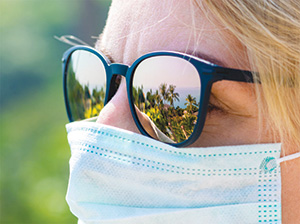Summer is not going to make the coronavirus go away, study concludes
 As the COVID-19 pandemic rumbles on, scientists are observing its features from every possible angle. Some scientists are trying to identify factors that reduce the speed of its spread.
As the COVID-19 pandemic rumbles on, scientists are observing its features from every possible angle. Some scientists are trying to identify factors that reduce the speed of its spread.
The authors of a recent study, published in the Canadian Medical Association Journal, asked whether school closures and other public health interventions result in a slowdown of the COVID-19 pandemic.
They also assessed whether geographical and meteorological factors play a part in curtailing the pandemic, including latitude, temperature, and humidity.
As expected, the authors found that “public health interventions were strongly associated with reduced epidemic growth.” However, more surprisingly, they concluded that the spread of SARS-CoV-2 was not associated with temperature.
VIRUSES AND TEMPERATURE
Scientists have established that influenza outbreaks — the most well-studied respiratory viral outbreaks — are associated with changes in climate; they tend to occur during colder months. However, questions remain as to why these viruses display such seasonality.
Although scientists are still investigating the matter, reduced case numbers in hotter months are likely to be due to higher temperatures, higher humidity, or higher solar radiation.
As the authors explain, “These three characteristics are all associated with geographic latitude, a measure that can be determined effortlessly and with precision.”
The fact that schools tend to close over the summer months could also play a part in reducing the risk of influenza outbreaks.
For the recent study, the researchers focused on data taken from “geopolitical areas with documented outbreaks of COVID-19” during two separate weeks.
They classed the first week — March 7–13, 2020 — as the exposure period. The authors took note of latitude, temperature, humidity, school closures, restrictions of mass gatherings, and physical distancing measures.
Then, they measured the increase in the number of COVID-19 cases 14 days later –– “the assumed time between transmission of SARS-CoV-2 and reporting of confirmed COVID-19 cases.”
During their analysis, the scientists controlled the data for a wide range of variables with the potential to skew the results. The variables included altitude, gross domestic product, percentage of inhabitants aged 65 years or older, population density, proximity to regions with established epidemics, such as Wuhan, China, and average life expectancy.
THE ANALYSIS
In all, the analysis used data from 144 geopolitical regions, including 375,609 cases of COVID-19. The scientists took data from the World Health Organization’s (WHO) Situation Report 61. This included state-level information for the United States and Australia, province- and territory-level data for Canada, and countrywide data for the rest of the world.
They excluded China because, at that point, the epidemic was waning there. They also excluded Italy, Iran, and South Korea because the epidemic was peaking in those countries.
The authors conclude that COVID-19 epidemic growth “was not associated with geographic latitude, nor with temperature during the exposure period 14 days before.”
This came as a surprise to the researchers. One of the authors, Dr. Peter Jüni from the University of Toronto, Canada, says, “We had conducted a preliminary study that suggested both latitude and temperature could play a role, but when we repeated the study under much more rigorous conditions, we got the opposite result.”
The scientists identified a relationship between epidemic growth and relative and absolute humidity, but when they carried out more detailed analyses, these relationships weakened. However, the authors believe that both dimensions of humidity may play a minor role but that “this remains hypothetical.”
PUBLIC HEALTH INTERVENTIONS
With some countries and communities considering easing their public health interventions, the findings are important. The authors write:
The scientists concluded that only area-wide public health interventions –– restrictions of mass gatherings, school closures and measures of social distancing –– were consistently associated with reduced epidemic growth.
The findings are particularly important as some countries and communities begin easing their public health interventions.
“Summer is not going to make this go away. It’s important that people know that,” one of the study’s authors, Prof. Dionne Gesink said. “These public health interventions are really important because they’re the only thing working right now to slow the epidemic.”
(Medical News Today)



Leave a Reply